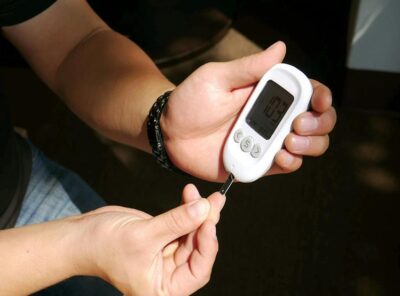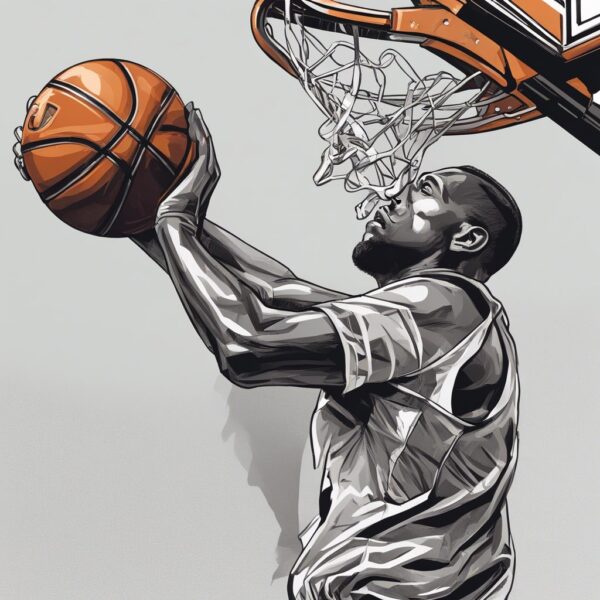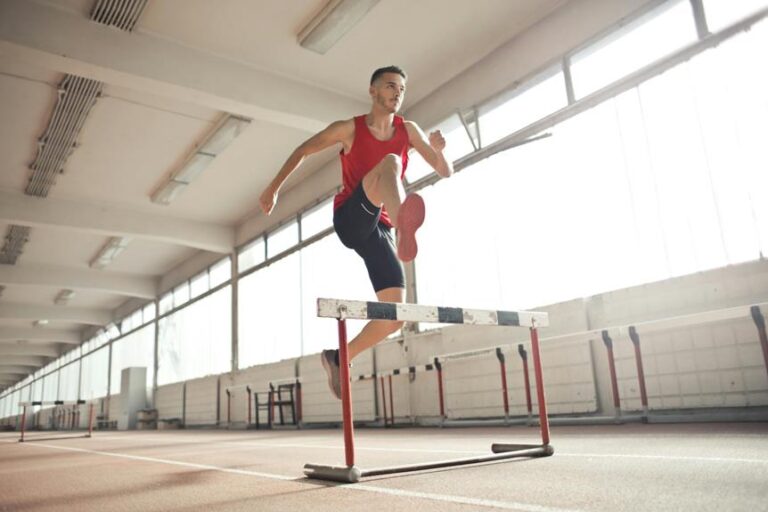10 Best Tools for Measuring Jump Height
To effectively measure jump height, consider using these top tools: Laser Measurement Devices, Force Plates, Infrared Sensors, High-Speed Cameras, and Wearable Accelerometers.
These tools offer advanced technology for precise calculations and real-time feedback, commonly used in sports science research to provide valuable insights for training optimization.
By connecting to smartphones or tablets, tracking progress over time becomes seamless, allowing you to set specific vertical jump goals, maintain focus, and enhance performance through goal-oriented training.
Athletes, coaches, and fitness enthusiasts benefit from these tools, enhancing vertical jump performance through personalized feedback and targeted training techniques.
The Vertec Jump Tester, Optojump System, My Jump 2 App, and Smart Jump Mat are also excellent options that can further elevate your measurement capabilities.
Key Takeaways
- Laser measurement devices offer precise jump height tracking.
- High-speed cameras provide accurate data on hang time and flight trajectory.
- Infrared sensors ensure advanced technology for calculating jump height.
- Wearable accelerometers enhance performance through real-time feedback.
- Force plates analyze vertical jump performance for training optimization.
1.Laser Measurement Devices
Laser measurement devices revolutionize jump height tracking on the basketball court. These cutting-edge tools use laser technology to calculate the vertical distance from takeoff to the highest point of a jump.
With their accuracy, athletes receive precise real-time feedback, enabling them to monitor their performance instantly.
Imagine the freedom of knowing exactly how high you jump and being able to make immediate adjustments to your training regime. These devices aren’t only accurate but also portable and easy to integrate into your jump training sessions.
By incorporating laser measurement devices into your routine, you can consistently track your progress and work towards improving your jump height with confidence.
2.Force Plates
Force plates play a crucial role in measuring ground reaction forces during a jump, offering precise data on jump height. Equipped with sensors, these specialized devices accurately capture the force exerted by athletes during takeoff and landing.
By providing real-time feedback, force plates help in analyzing and improving jump performance. The data collected can track progress, pinpoint weaknesses, and customize training programs to boost vertical jump height.
Advanced technology in force plates allows for detailed biomechanical analysis, making them invaluable for evaluating sports performance and preventing injuries.
When aiming for best results, utilizing force plates enhances your ability to understand and enhance your jumping technique, ultimately leading to improved athletic performance.
3.Infrared Sensors
By detecting the time it takes for an individual to reach their peak height, infrared sensors accurately measure jump height using advanced technology. These sensors, utilizing infrared technology, provide precise calculations of jump height.
Commonly employed in sports training and research, they offer instant feedback on performance, enabling real-time adjustments to technique.
Beyond jump height, some infrared sensor systems can also analyze hang time and flight trajectory, offering a thorough assessment of performance. This detailed analysis aids in tracking progress and enhancing athletic abilities.
With their ability to deliver immediate and accurate data, infrared sensors are valuable tools for individuals seeking to improve their jumping skills.
4.High-Speed Cameras
To further enhance your understanding of jump height measurement tools, let’s shift our focus to the utilization of high-speed cameras.
High-speed cameras are powerful tools that can capture detailed footage at high frame rates, enabling accurate measurement of jump height. Here are some key points to take into account:
- High-speed cameras record slow-motion videos, allowing for precise analysis of your vertical leap performance.
- Advanced software, when paired with high-speed cameras, can calculate jump height by tracking essential points during your jump.
- These cameras are widely used in sports science research to assess athletic performance metrics like vertical jump height.
- The data collected from high-speed cameras offers valuable insights for optimizing training and enhancing your jumping abilities.
5.Wearable Accelerometers
Utilize wearable accelerometers to precisely measure jump height by tracking body acceleration and motion. These small devices, equipped with advanced sensors and algorithms, accurately monitor your movements during a jump.
By attaching them to your body, you can receive real-time feedback on your jump height, enabling you to fine-tune your performance.
Widely used in sports science research, training programs, and athletic performance analysis, these accelerometers offer valuable insights into your jumps.
Some models even come with extra features like data logging, wireless connectivity, and compatibility with mobile apps for in-depth analysis.
Elevate your jump training and performance assessment by incorporating wearable accelerometers into your routine for a more thorough understanding of your vertical abilities.
6.Pressure Sensors
Pressure sensors, commonly embedded in platforms or mats, accurately measure the force of a jump to calculate the height reached. Here are four reasons why pressure sensors are beneficial for tracking jump height:
- Real-time Data: Pressure sensors provide instant feedback on jump height, enabling you to adjust your technique on the spot.
- Progress Tracking: By using pressure sensors, athletes and coaches can monitor improvements in jump height over time.
- Training Optimization: The data collected by pressure sensors helps tailor training programs to enhance performance and reduce the risk of injuries.
- Accessibility: With advancements in sensor technology, accurate jump height measurements are now more readily available to athletes at all skill levels.
7.Vertec Jump Tester
The Vertec Jump Tester is a widely-used vertical jump measurement device in sports performance testing. It features a set of vanes that athletes displace by reaching up, providing a quick and accurate assessment of explosive power and lower body strength.
Coaches and athletes utilize this tool to track progress, set goals, and enhance vertical jump performance.
The Vertec Jump Tester is portable, easy to set up, and extensively employed in various sports training programs for measuring jump height.
| Features | Benefits | Applications |
|---|---|---|
| Vanes for reaching up | Quick and accurate assessment | Sports performance testing |
| Portable and easy setup | Helps track progress and set goals | Various sports programs |
| Measures jump height | Enhances vertical jump performance |
8.Optojump System
The Optojump System, with its bar system equipped with infrared LEDs and receptors, is a highly accurate tool extensively employed in sports and fitness environments to measure jump height. Here are four reasons why you’ll appreciate using the Optojump System:
- Precision: Get detailed data on various jump parameters for accurate analysis.
- Real-time Feedback: Receive instant insights into your jump performance, aiding in training and progress tracking.
- Portability: Easily transport this system wherever you go for on-the-go jump height measurements.
- Ease of Use: Simple setup makes it convenient for athletes, coaches, and researchers to assess vertical jump abilities with ease.
Experience the freedom of precise jump height measurements with the Optojump System!
9.My Jump 2 App
Optimizing your jump training regimen is made seamless with the My Jump 2 App, a cutting-edge tool for accurately measuring vertical jump performance.
This popular app doesn’t just stop at providing your jump height; it goes the extra mile by offering detailed insights into your hang time and jump efficiency.
By utilizing advanced algorithms, My Jump 2 analyzes your jump data to give you valuable feedback on how to enhance your performance.
Whether you’re an athlete, coach, or fitness enthusiast, this app allows you to track your progress over time and set personal goals for vertical jump training.
With its wide usage and reputation for precision, My Jump 2 is a go-to choice for those serious about improving their vertical jump abilities.
10.Smart Jump Mat
For accurate measurement of your vertical jump height, consider incorporating the Smart Jump Mat into your training regimen. Here are four reasons why the Smart Jump Mat could be a game-changer for your vertical jump training:
- Instant Feedback: Get immediate results on your jump height, allowing you to adjust and improve in real-time.
- Data Tracking: Connect to your smartphone or tablet via Bluetooth to monitor your progress and analyze trends over time.
- Goal Setting: Set specific vertical jump goals and track your advancements to stay motivated and focused.
- Performance Optimization: Used by athletes, coaches, and fitness enthusiasts, the Smart Jump Mat helps enhance your vertical jump performance through targeted training.
Frequently Asked Questions
What Tool Is Used to See How High You Jump?
To see how high you jump, you can use a vertical jump tester. It calculates your jump height by timing how long it takes for you to reach a specific height. These tools are common in sports and fitness for tracking progress.
What Device Measures Jump Height?
To measure jump height accurately, devices like the Vertec Vertical Jump Measuring Device and the My Jump 2 app are excellent choices. They use sensors and technology to calculate vertical leap based on air time and landing impact.
How Do You Measure Height of Jump?
To measure the height of a jump, reach for the sky and then leap with all your might. Subtract your reach from where your fingertips touch during liftoff. Keep track of your progress and soar higher every time.
Is a 21 Inch Vertical Good?
A 21-inch vertical jump is below average for many athletes, especially in sports like basketball and volleyball. Aim for 28-40 inches to excel. Strengthen your legs, work on explosiveness, and improve technique to boost your vertical jump.
Conclusion
Now that you have explored the top tools for measuring jump height, you’re equipped with the knowledge to take your training to the next level.
Whether you choose a laser measurement device or a smart jump mat, each tool offers unique benefits to help you track your progress and improve your vertical leap.
With these tools in hand, you can confidently work towards reaching new heights in your athletic performance.
Keep jumping and reaching for the stars!











